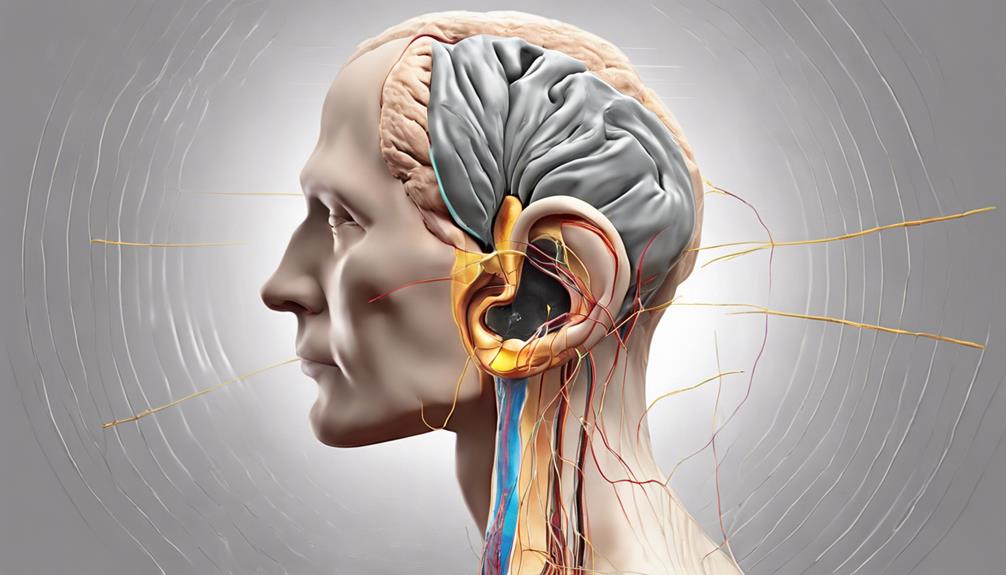Neuromodulation devices can provide significant relief for conditions like chronic pain, Parkinson’s, or epilepsy, often improving quality of life. While they offer targeted treatment and have advanced with newer, more comfortable, and personalized options, consider potential risks like device malfunction or costs. Their long-term effectiveness varies and depends on device durability and proper management. To determine if they’re a good fit for your needs, explore the latest innovations and patient experiences to make an informed choice.
Key Takeaways
- Neuromodulation devices can significantly reduce symptoms and improve quality of life for chronic conditions, potentially justifying the investment.
- Advances like closed-loop systems and personalized stimulation enhance treatment effectiveness and long-term benefits.
- Potential risks, device malfunctions, and maintenance costs should be weighed against symptom relief and functional improvements.
- Long-term data on device durability and sustained efficacy are still emerging, impacting overall value assessment.
- Patient success stories often highlight meaningful improvements, making neuromodulation a worthwhile option for suitable candidates.
How Do Neuromodulation Devices Work?

Neuromodulation devices work by delivering targeted electrical or magnetic signals to specific areas of your nervous system. This process relies on careful device customization to guarantee the stimulation matches your unique needs. During treatment planning, healthcare providers focus on patient selection, choosing individuals who are most likely to benefit from the therapy. They assess factors like the condition’s severity and your medical history to determine suitability. Once implanted or applied externally, these devices send precise signals that modulate nerve activity, helping reduce symptoms like pain or tremors. The effectiveness hinges on accurate device customization and careful patient selection, which optimize outcomes. This tailored approach ensures you receive a treatment that’s specifically designed to address your condition safely and effectively. Additionally, understanding the role of contrast ratio can aid in evaluating device performance and image clarity during the development and testing phases.
The Latest Technologies in Neuromodulation

The latest neuromodulation devices feature innovative designs that improve user comfort and treatment precision. Advances in stimulation techniques now allow for more targeted and adaptable therapy options. These technological breakthroughs are shaping the future of personalized neuromodulation treatments. Additionally, master the art of smart shopping techniques can help patients find reliable devices at the best prices.
Innovative Device Features
Advancements in device technology are transforming neuromodulation, enabling more precise and personalized treatments. Innovative device features now focus on enhanced device customization and intuitive user interfaces, making therapy more accessible and efficient. Imagine adjusting stimulation settings through a sleek touchscreen, or customizing programs tailored to your unique needs. These features allow you to control therapy with ease, improving comfort and outcomes. Picture a device that learns your patterns and automatically adapts, minimizing manual input. The latest devices often include wireless connectivity, enabling remote adjustments and monitoring. Visualize a compact, discreet implant that seamlessly integrates with your lifestyle. Additionally, incorporating Kia Tuning principles—such as performance enhancements and customization options—can inspire innovations in device design and functionality. These innovations make neuromodulation more user-friendly, empowering you to take charge of your treatment and experience better results.
Advances in Stimulation Techniques
Recent innovations in stimulation techniques are revolutionizing how neuromodulation therapies target specific neural pathways, resulting in more effective and tailored treatments. Advances like closed-loop systems adjust stimulation in real-time based on patient responses, harnessing neuroplasticity research to enhance neural rewiring. Device miniaturization plays a pivotal role, enabling less invasive procedures and more precise targeting of neural circuits. These smaller, smarter devices improve patient comfort and expand treatment options for complex conditions. New stimulation patterns, such as burst and high-frequency modes, optimize neural engagement and neuroplasticity, leading to better outcomes. As technology evolves, these latest techniques promise to make neuromodulation more effective, personalized, and accessible for a wider range of neurological and psychiatric disorders.
Common Conditions Treated With Neuromodulation

Are you wondering which conditions neuromodulation devices can effectively treat? These devices work by influencing neuron interaction, helping to regulate abnormal signals. Thanks to device miniaturization, they can target specific nerve pathways with precision. Common conditions include:
- Chronic pain syndromes, like back or limb pain
- Parkinson’s disease, improving motor control
- Epilepsy, reducing seizure frequency
- Depression resistant to medication
- Urinary or fecal incontinence
These conditions often involve disrupted neural signals, which neuromodulation can restore. By adjusting neural activity, the devices provide relief where traditional treatments may fall short. As technology advances, the ability to fine-tune neuron interaction with smaller, more efficient devices makes neuromodulation an increasingly versatile option. Relationships between neural pathways are fundamental to understanding how neuromodulation achieves its therapeutic effects.
Benefits and Potential Risks of Using These Devices

Neuromodulation devices can offer significant relief from symptoms, but they also come with potential side effects and complications. You should consider the long-term effectiveness, which remains uncertain for some users. Understanding these benefits and risks helps you make informed decisions about using these technologies. Additionally, consulting with a qualified healthcare professional can help evaluate the safety and suitability of ethical hacking principles when considering new medical devices.
Improved Symptom Relief Potential
While neuromodulation devices can offer significant relief from symptoms, they also come with potential risks that you should consider. These devices aim to target specific neural pathways, often providing better symptom control than traditional treatments. They can be a powerful addition to your management plan, especially when combined with alternative therapies and lifestyle modifications. Imagine experiencing less pain or improved function, feeling more like yourself. However, it’s important to picture possible scenarios:
- A device gently stimulating nerves, easing chronic pain
- Precise targeting reducing reliance on medication
- A wearable device discreetly fitting into your daily routine
- Enhanced quality of life with fewer symptoms
- Complementing traditional treatments for all-encompassing relief
While the potential is promising, understanding both the benefits and the limitations helps you make an informed decision. Additionally, for those interested in alternative energy sources, electric power generation with bike generators offers a sustainable option for small-scale energy needs.
Side Effects and Complications
Although neuromodulation devices can provide significant symptom relief, they also carry potential side effects and risks you should consider. Device malfunctions can occur, leading to sudden loss of benefits or unexpected sensations, which may require adjustments or replacements. Allergic reactions to device components, such as skin irritation or inflammation, are also possible, especially if you have sensitive skin. In some cases, improper placement or technical errors can cause discomfort or nerve damage. While serious complications are rare, these risks highlight the importance of close monitoring and regular follow-up with your healthcare provider. Being aware of dog breeds that are commonly used in therapy or assistance roles can help you understand how some breeds are suited for specific needs, which is valuable when considering devices that assist with mobility or neurological function. Understanding potential device malfunctions and allergic reactions helps you weigh the benefits against the risks before deciding on neuromodulation therapy.
Long-Term Effectiveness Uncertainty
Have we fully understood the long-term benefits and risks of using neuromodulation devices? This uncertainty stems from limited data on device durability and maintenance needs over extended periods. You might wonder if these devices will function reliably years down the line or if you’ll face frequent repairs. Potential issues include battery life depletion, hardware wear, or the need for surgical replacements. Maintenance requirements can vary, affecting the device’s longevity and your overall experience. While some patients see lasting relief, others encounter diminishing benefits over time. The lack of extensive long-term studies means you’re navigating uncharted territory, balancing hope with caution. Ensuring durability and understanding maintenance demands are key to making an informed investment in neuromodulation technology. Additionally, ongoing research into effective device lifespan and maintenance strategies is crucial for better long-term outcomes.
Cost and Insurance Coverage Considerations

Cost and insurance coverage are critical factors that can influence your ability to access neuromodulation devices. Conducting a thorough cost analysis helps you understand the expenses involved, including device costs, procedure fees, and follow-up care. Insurance policies vary widely, so it’s essential to review your coverage carefully. Some plans may cover the device and implantation, while others might limit reimbursement or require prior authorization. Out-of-pocket costs can add up quickly, making affordability a real concern. To navigate this, you should contact your insurer to clarify what’s covered and explore financing options if necessary. Being informed about your insurance policies and potential costs ensures you’re better prepared to make an informed decision about pursuing neuromodulation therapy. Additionally, understanding the cost factors involved can help you compare options and plan accordingly.
Long-Term Effectiveness and Evidence

Understanding the long-term effectiveness of neuromodulation devices is key to determining if they’re a worthwhile investment. While some studies show promising results, evaluating device durability and patient adherence over time is essential. You should consider whether the device maintains its functionality after years of use and if patients consistently follow treatment protocols. Long-term evidence indicates that sustained benefits depend on these factors, influencing overall success. Additionally, incorporating sound design techniques such as sound analysis can help monitor device performance and patient feedback more effectively.
Patient Experiences and Success Stories

Patients often share inspiring success stories after using neuromodulation devices, highlighting how these technologies can transform their quality of life. Many report significant pain relief, improved mobility, and a renewed sense of hope, which they share through heartfelt patient testimonials. These success stories illustrate the real impact of neuromodulation on daily living, showing that what once seemed impossible becomes manageable. Hearing from others who’ve experienced positive outcomes can boost your confidence in trying these devices. While individual results vary, these testimonials often emphasize increased comfort, better sleep, and reduced reliance on medications. Ultimately, these patient experiences serve as powerful evidence of how neuromodulation can genuinely enhance well-being and provide a new outlook on life.
Making an Informed Decision: Is It Right for You?

Hearing about others’ success stories can be inspiring, but deciding if a neuromodulation device is right for you requires careful consideration of your personal health needs and lifestyle. You should evaluate how device customization fits your specific condition and whether the potential benefits outweigh risks. Think about your daily routines and if the device integrates smoothly into them. Ethical considerations also matter—are you comfortable with the long-term impacts and data privacy?
To help decide, picture:
- Adjusting device settings for optimal comfort
- Managing device maintenance and follow-ups
- Balancing potential risks with quality of life improvements
- Charting ethical questions around data and consent
- Ensuring support from your healthcare team
Frequently Asked Questions
Are Neuromodulation Devices Suitable for Children or Adolescents?
You might wonder if neuromodulation devices suit children or adolescents. These devices are increasingly used, but pediatric safety remains a top priority, and research is ongoing. You should consider that adolescent efficacy is promising, yet results vary. Consult healthcare professionals to evaluate individual needs, ensuring safety and effectiveness. While promising, neuromodulation devices should be used cautiously in younger populations until more detailed data confirms their suitability.
How Do I Choose the Right Neuromodulation Device for My Condition?
Thinking about your options can feel like steering a complex path, but focusing on device selection and treatment compatibility guides you. You’ll want to consult with your healthcare provider to understand which device aligns best with your condition’s nuances. Consider how each device interacts with your specific symptoms and lifestyle. By doing so, you’ll find a tailored approach that offers the best chance for relief, making the journey smoother and more effective.
What Are the Signs That a Neuromodulation Device Is Not Working?
You’ll notice signs that your neuromodulation device isn’t working if you experience device malfunction, like unexpected pain or no relief from symptoms. Ineffective stimulation might cause little to no improvement in your condition, despite proper use. If you notice any device issues, such as battery problems or irregular sensations, it’s essential to contact your healthcare provider promptly. Addressing these signs early helps guarantee your treatment remains safe and effective.
How Often Do Neuromodulation Devices Require Maintenance or Replacement?
Think of your neuromodulation device as a trusty car—regular maintenance keeps it running smoothly. Usually, these devices are built for durability, but the need for maintenance frequency varies, often every 3 to 5 years. Replacement might be necessary if the device shows signs of wear or decreased effectiveness. Regular check-ups guarantee your device remains in top shape, so you get the best results without surprises.
Can Neuromodulation Devices Be Used Alongside Other Treatments or Medications?
You can definitely use neuromodulation devices alongside other treatments or medications, enhancing your overall therapy. This combination therapy often results in medication synergy, where the device and meds work better together. It’s important to consult your healthcare provider to guarantee compatibility and optimize your treatment plan. Combining therapies might improve symptom control and reduce medication doses, making your experience more effective and manageable.
Conclusion
Deciding whether neuromodulation devices are worth it is like planting a seed—you need patience, hope, and the right care. While these devices bring promising relief and can transform lives, they also come with costs and uncertainties. Weigh the benefits against the risks, and listen to real patient stories. Ultimately, making an informed choice means trusting your instincts and working closely with your healthcare team to nurture your path toward better health.











